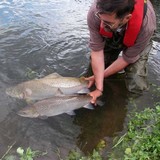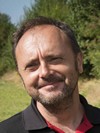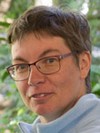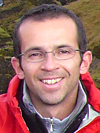SAMARCH
 |
Salmonid Management Round the Channel |
|
Research
Context and Issues
Multiple environmental disturbances are likely responsible for the decline in abundance of Atlantic salmon and sea trout populations by about 70% since the 1970s across the North Atlantic. The estuarine, coastal and marine phases of the life cycle of these migratory salmonids remain poorly understood. However, they are key phases that influence many life history traits, such as migration, dispersal, growth and fish survival. Current knowledge suggests that multiple pressures during these key phases of the life cycle partly explain the changes observed in these populations.
Objectives
The SAMARCH project has two objectives:
- (1) fill gaps in knowledge about the ecology of the estuarine, coastal and marine phases of these migratory salmonids,
- (2) transfer this knowledge to improve management of these populations on both sides of the English Channel (France and England) and beyond.
Methodology
The research is based largely on long-term monitoring programmes of several coastal rivers, including five reference (“index”) rivers for salmonid population monitoring at national and international levels; two in England (Frome and Tamar) and three in France [Scorff, Oir and Bresle, part of the Research Observatory of Small Coastal River Environments (ORE PFC)]. The project is organised into 4 technical work packages:
- (1) Analysing movements of sea trout and salmon during migration in estuaries and coastal areas to identify their behaviour, habitat preferences and to quantify mortality during this critical phase of the life cycle. These analyses will be based on acoustic monitoring, acoustic markers implanted in fish caught during migration, and a network of receivers installed in the estuaries of the Frome, Tamar, Scorff and Bresle rivers in the spring of 2018 and 2019.
- (2) Developing a genetic database (i) to improve knowledge about the origin of sea trout caught by commercial fishermen at sea, and (ii) to obtain new knowledge about the dispersal and habitat preferences of sea trout in the Channel. A map based on the Channel seascape will be developed to predict the importance of different coastal areas for sea trout.
- (3) Combining the knowledge obtained in the first two work packages with analysis of individual growth trajectories based on historical collections of scales available for index rivers at several stages of the life cycle (juvenile, smolt, and adults). These new data will be integrated into population dynamics models to provide information for management. This knowledge will improve understanding and modelling of mechanisms that influence interannual variations in growth and survival based on the sex of individuals and in response to changes in the environment.
- (4) Ensuring that results are shared with stakeholders to provide information for and improve the management of migratory salmonid populations in the Channel’s estuaries and coastal waters. The active involvement of students will help train the managers of tomorrow and increase awareness of issues involving migratory fish.
Expected Results
Expected results include:
- (1) better understanding of migratory behaviour and mortality factors of salmon and sea trout during the initial months of the marine phase (estuary and coastal area),
- (2) better understanding of the spatial structure of meta-populations of sea trout
- (3) retrospective analysis of changes in growth in salmon and sea trout during the marine phase (scale retro-measurements) over the past 40 years,
- (4) integration of this new knowledge into population dynamics models used as decision support tools,
- (5) sharing of project results with stakeholders to improve management policies for salmonids in estuaries and coastal waters.
Publications issued from the project
Tréhin Cécile, Rivot Etienne, Lamireau Ludivine, Meslier Lisa, Besnard Anne-Laure, Gregory Stephen, Nevoux Marie (2021). Growth during the first summer at sea modulates sex-specific maturation schedule in Atlantic salmon. Canadian Journal of Fisheries and Aquatic Sciences, NRC Research Press, 2021, 78 (6), pp.659-669. ⟨10.1139/cjfas-2020-0236⟩
PECHIERAS, F. (2021) .Reponse des populations de saumon atlantique aux changements de l?ecosysteme marin : analyse de la variabilite spatio-temporelle des histoires de vie pendant la phase marine
ARTERO, C. STEVENS, J. KING, A. LAUNEY, S. NEVOUX, M. GREGORY, S.D. RIVOT, E. ROBERTS, D. (2021) .Actualite du projet SAMARCH
Olmos Maxime, Payne Mark, Nevoux Marie, Prévost Etienne, Chaput Gerald, Du Pontavice Hubert, Guitton Jérôme, Sheehan Timothy, Mills Katherine, Rivot Etienne (2020). Spatial synchrony in the response of a long range migratory species ( Salmo salar ) to climate change in the North Atlantic Ocean. Global Change Biology, Wiley, 2020, 26 (3), pp.1319-1337. ⟨10.1111/gcb.14913⟩
TREHIN, C. RIVOT, E. LAMIREAU, L. MESLIER, L. BESNARD, A.-L. GREGORY, S.D. NEVOUX, M. (2020) .Growth during the ggyeoltrst summer at sea modulates sex-speciggyeoltc maturation schedule in Atlantic salmon
LAUNEY, S. BESNARD, A.-L. LAMIREAU, L. (2019) .Recolter des ecailles de truites de mer : pourquoi et comment ?
TRUEMAN, C. ROUSSEL, J.-M. MACKENZIE, K. (2019) .Isotope chemistry of scales reveals continent-scale variation in at-sea foraging in European populations of Atlantic salmon
TREHIN, C. RIVOT, E. EVANNO, G. LAMIREAU, L. NEVOUX, M. (2019) .Long-term changes in marine growth and relationships with life history strategies of Atlantic salmon Salmo salar
LAUNEY, S. (2018) .Paysage marins, schemas migratoires et structure genetique de la truite de mer
BEAULATON, L. JOSSET, Q. NEVOUX, M. BAGLINIERE, J.-L. (2018) .La truite de mer : une gestion complexe
People involved
 |
AMILIEN Flavie, Technician Phone : +33 2 23 48 56 69 Email : flavie.amilien@inrae.fr |
 |
BERNEZ Ivan, Scientist Phone : +33 2 23 48 55 41 Email : ivan.bernez@institut-agro.fr |
 |
BESNARD Anne-Laure, Technician Phone : +33 2 23 48 54 43 Email : anne-laure.besnard(at)inrae.fr |
 |
BOISSON Pierre-Yves, Technician Phone : +33 2 23 48 54 43 Email : pierre-yves.boisson@inrae.fr |
 |
JOUSSEAUME Thibaut, Technician Phone : +33 2 23 48 53 43 Email : thibaut.jousseaume@inrae.fr |
 |
LASSALLE Gilles, Scientist Phone : +33 2 23 48 56 61 Email : gilles.lassalle@inrae.fr |
 |
LAUNEY Sophie, Scientist Phone : +33 2 23 48 52 35 Email : sophie.launey@inrae.fr |
 |
NEVOUX Marie, Scientist Phone : +33 2 23 48 50 15 Email : marie.nevoux@inrae.fr |
 |
PATIN Rémi, Scientist |
 |
QUEIROS Quentin, Scientist Phone : +33 2 23 48 58 20 Email : quentin.queiros@inrae.fr |
 |
RIVOT Etienne, Scientist Phone : +33 2 23 48 59 34 Email : etienne.rivot@institut-agro.fr |
 |
ROUSSEL Jean-Marc, Scientist Phone : +33 2 23 48 57 75 Email : jean-marc.roussel@inrae.fr |
 |
TREHIN Cécile, Ph.D. Phone : +33 2 23 48 70 38 Email : cecile.trehin@inrae.fr |
Partners
Funding and Support
SAMARCH est un projet de cinq ans bénéficiant d'une subvention de 877 millions d'euros dans le cadre du programme Interreg France-Manche-Angleterre de l'UE
